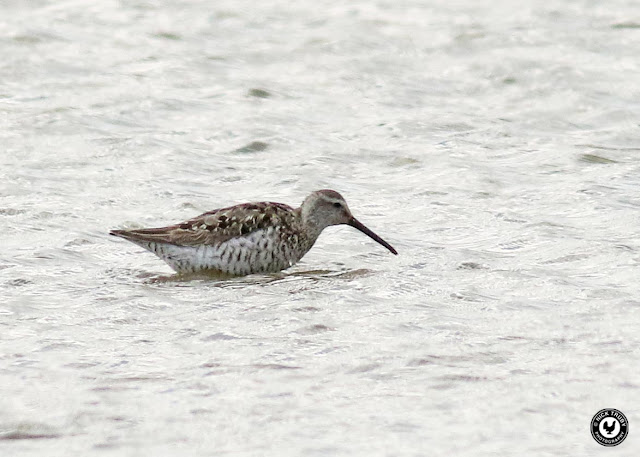A long line of birdwatchers were looking over the reedbed scrape from the main path, their interest centring on the large group of Black-tailed Godwits that stood resting and asleep. I asked one of my fellow twitchers where the Stilt Sandpiper might be and was told it was asleep in amongst the Godwits but was tricky to pick out at the distance. I set up the scope ready to trawl through the birds when I heard a chap, who was walking back to the visitor centre, telling all and sundry that the star bird was in fact on pools on the north scrape and showing well. We went straight there at as quick a pace as we could manage and 20 minutes later joined a bigger throng of birders alongside the pools. The Stilt Sandpiper was out of view behind some grasses but soon emerged into full view and another tick went onto the life list.
The Stilt Sandpiper had been found on Wednesday, I almost drove to see it then but thought better of it, I am not a full on twitcher. It had been very site faithful since then, either feeding where it was now or on the reedbed scrape. Despite only being a little larger than a Dunlin, albeit with much longer legs, it chose to feed with the much larger Black-tailed Godwits. For most of the time that we observed the bird it was wading belly deep with its head under the water in its search for food. It was tricky getting images of the bird with its head out of the water!
 |
| typical view with head submerged! |
The Stilt Sandpiper was also about 30-40 yards away which is ok for great views through the scope but just a little bit too far for decent photos, hence the "record" shot quality of all of my shots. The sunshine didn't help matters either, killing off any contrast and the best pictures were obtained when a cloud obscured the sun. I know it was difficult because everybody with a camera, even those with the big long lenses, were voicing the same complaints. You just can't please bird photographers sometimes!
We had tried in vain to see a Stilt Sandpiper at Weymouth two years ago and didn't bother going for the one that visited Poole Harbour last summer, so it was nice to finally catch up with one. After ticking the long awaited Buff-breasted Sandpiper (see Buff-breasted ) at Blacktoft Sands a few weeks ago, getting this bird was a well received bonus. Stilt Sandpipers breed in North America and are vagrants to the UK and it's mainly adults that arrive in the late summer so this bird was conforming to established habit. It's slightly bigger than Dunlin but, as mentioned, has much longer legs. The bill is fairly long and droops towards the tip, making it superficially like a Curlew Sandpiper but those legs are much longer than its cousin. The underparts are barred and the upper parts are rather plain grey-brown lending it a resemblance to a Dowitcher (a Long-billed Dowitcher was amazingly found about a mile away from the Stilt Sandpiper on Friday! Sadly not seen again today) but that species has a much longer "snipe" like bill. From our viewing distance the supercilium was a very striking feature.
We spent a couple of hours watching the bird which was always on view unless it fed behind one of the isolated patches of grass. It kept the company of several Black-tailed Godwits, generally staying out in the deeper water so the full extent of its legs were rarely seen. Other wading birds were feeding around the edges of the pools, we saw Dunlin, Common Snipe, Ringed and Little Ringed Plovers. There were Pied Wagtails too.
 |
| feeding with a Black-tailed Godwit |
 |
| Black-tailed Godwit |
Because we'd been here so recently, we had already decided that this would be a twitch only day so apart from a cursory inspection of the other scrapes where we noted Avocets, various common waterfowl and a plethora of Swallows and Martins, we were soon in the car and heading home. We made a stop at the Ship Inn at Surfleet on Seas (the sea is miles away!) for some lunch where I chose a Steak and Stilton toasted sandwich. Of course!














No comments:
Post a Comment